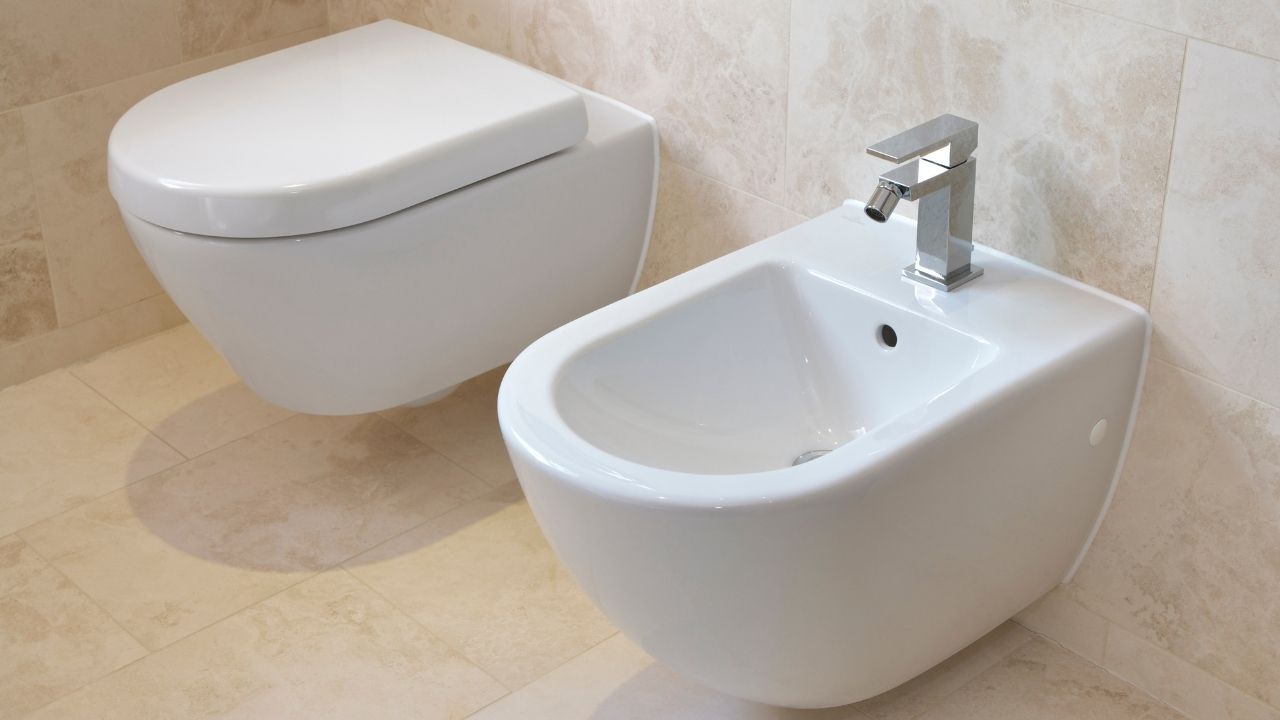Lifestyle
What Is a Bidet and Why Do You Need One?

Many Americans don’t know what a bidet is, let alone why you would need one.
That’s because bidets (pronounced “bi-day”) are a French invention that have yet to become widespread in the US.
But they’re very popular in Asia, Europe, and the Middle East. For example, over 77.5% of Japanese homes have one.
What Is a Bidet?
A bidet is a bathroom appliance that sprays water on your bottom to clean you after you’re done going to the bathroom. It’s an alternative to using toilet paper. There are different types of bidets: stand-alone, handheld, toilet seat, attachment, and even travel versions.
Stand-alone bidets are often mistaken for a low sink or a urinal. That’s what they look like. However, they’re meant to be squatted over after using the toilet for cleaning yourself.
A handheld bidet, aka a bidet shower or shattaf, is a little hose that you can hold and direct with your hand. They’re a nice DIY option because they’re easy to install.
Other bidets are integrated into the toilet seat. These are nice because they don’t require you to move from the toilet seat at all. A spray nozzle extends beneath you when you’re ready and then retracts when you’re done. Many toilet seat bidets also come with added features like heated seats and air drying.
Bidet attachments fit underneath the toilet seat and use water pressure. You adjust the nozzle spray by turning a dial. These are also one of the more cost-effective options since they don’t require any electricity.
Finally, travel bidets are handy for when you’re on the road and don’t want to resort to toilet paper. They look like a bottle and have a skinny cap that squirts out water when you squeeze it.
Benefits of Using a Bidet
Now that you know what types of bidets are out there, why should you use one? Well, they have many benefits over toilet paper. Let’s go over them:
- Bidets are cleaner. Think about it: If you were to get mud on your skin, you’d want to wash it off with water. You wouldn’t use dry paper to scrape it off. But that’s basically what we do when we use toilet paper, and it doesn’t get everything. It leaves residue. Plus, you don’t have to use your hands when you use bidets, so they’re more hygienic because there’s less opportunity for germs to spread.
- Bidets are also better for the environment. We use 22 billion kilometers of toilet paper globally per year. And each year it costs 712 million trees, 1,165 million tons of water, and 78 million tons of oil. Using a bidet dramatically reduces the amount of toilet paper you use since you only need it to dry. And if you get a bidet with an air dryer function, you don’t need to use any toilet paper at all. And by not buying toilet paper, you also need to dispose of less plastic packaging.
- Bidets can save you a ton of money. The average American spends over $11,000 on toilet paper in their lifetime. That’s over $140 per year. But with a bidet, you don’t need toilet paper. And if you consider that it takes about 6 gallons of water to make one roll of toilet paper, using bidets saves a lot of water as well.
- Another reason to love bidets is that they minimize your plumbing issues. Since you use less toilet paper, there are less opportunities for your pipes to clog. That means you don’t have to call the plumber as often, which will save you a lot of stress and money in the long run.
- Finally, using a bidet is a pleasant experience. While toilet paper can be rough on your skin, bidets are far more gentle and comfortable. They may take some time to get used to, but once you do, it’s hard to go back.
Final Thoughts
Whether you decide to invest in a bidet or not, it’s worth a try. So the next time you see one, resist the urge to use toilet paper like you always do and try something new.
And if you do invest in one, remember to clean it regularly. Then enjoy it and consider introducing your family and friends. Bidets are bound to spread across the US as more people recognize the many benefits.
Lifestyle
How Magic Moment Resort Became the Pioneer of a New Era: The First-Ever Dazzler Select by Wyndham

In Central Florida’s packed landscape of family hotels and theme park lodgings, a unique kind of property has emerged. Magic Moment Resort & Kids Club in Orlando is earning attention from traveling families for a simple reason. It delivers joy, warmth, and convenience at a smart value that keeps Disney dreams accessible rather than overwhelming.
By joining Wyndham, Magic Moment Resort unlocks the strength of a global powerhouse, gaining worldwide visibility, advanced technology, and access to Wyndham Rewards, the largest hotel loyalty program on the planet. This strategic move expands its reach, builds guest trust, and amplifies its impact, all while preserving the unique identity that sets it apart.
Just a short drive from the gates of Walt Disney World, the resort sits along the palm-framed stretch of West Irlo Bronson Memorial Highway. The location has long been known for its tourism bustle, yet Magic Moment has carved out a softer identity. It feels playful and colorful, but also intentional. It is designed by a family for other families, and that perspective shapes every experience on the property.
A Philosophy Rooted in Family Connection
Magic Moment Resort was built with a belief often forgotten in today’s tourism industry. Family vacations should feel uplifting instead of stressful, and affordability should not come at the expense of comfort or creativity.
Check-in feels more personal than transactional. Parents arrive with strollers, snacks, and tired children. The staff seems to understand this rhythm instinctively. The energy is warm, the pace is easy, and the tone is set long before anyone even enters the room.
Unlike competing hotels that charge a steep premium for proximity to the parks, Magic Moment focuses on smart value without compromise. Its pricing strategy is refreshingly straightforward. Families can stay five minutes from Disney without draining their travel budgets. For many guests, that difference helps shift resources from hotel costs to experiences. It means more character breakfasts, more souvenirs, and more freedom to enjoy the parks without financial tension following every decision.
Spaces Designed for Children and Considerate of Parents
Magic Moment is filled with color, but nothing feels overstimulating. Instead, the resort offers a sense of wonder scaled to a child’s imagination.
The themed family rooms are a highlight. Children step into rooms that feel lighthearted and whimsical, yet parents appreciate that they are also functional and comfortable. It is the atmosphere of a themed suite without the theme park price.
Its Kids Club and Teens Club reflect that same thoughtful balance. These spaces invite exploration and creativity for children and provide a nurturing level of supervision. Parents can enjoy an hour by the heated pool, relax in a shaded cabana, or simply take a quiet moment while knowing their children are safe and engaged.
The resort’s grounds encourage slow mornings and gentle afternoons.There’s a 30,000 sqf outdoor playground as well as peaceful corners for parents. Importantly, families are not asked to pay additional fees to enjoy them. Magic Moment’s amenities feel generous rather than transactional.
Unforgettable Days at the Parks
For families navigating a Disney vacation, convenience is often the true luxury. Magic Moment delivers this with a complimentary delicious hot breakfast that encourages everyone to sit and enjoy the start of the day rather than rush through it.
Transportation to the parks is included, which removes one of the most common stress points for visiting families. There is no parking lot maze and no long lines at the toll booths. Guests simply board the shuttle and begin their day with ease.
When the sun sets and everyone returns from a day of rides and parades, the resort becomes a place to unwind. Children head straight for the pool. Parents sip Starbucks coffee. The atmosphere is relaxed and bright, and the resort feels like an extension of the Disney experience rather than a pause from it.
A Value That Resonates with Families
What truly elevates Magic Moment is the balance it achieves between smart value and experience. The resort has cultivated a loyal following because guests feel they receive more than they pay for. More thoughtful design. More space for connection. More comfort without excess.
Affordability here does not signal minimalism. Instead, it allows families to breathe. It creates space for shared moments that are often overlooked in the rush of theme-park vacations. Children play freely. Parents unwind without guilt. Families spend more time together and less time navigating logistics.
A Resort Built with Heart
Magic Moment Resort & Kids Club stands out in a region overflowing with hospitality options. Its charm is not rooted in extravagance. It is grounded in sincerity. It reflects the belief that family travel should feel joyful, accessible, and full of color.
For families planning a Disney visit, it represents more than a place to sleep. It is a retreat where memories can form in the quiet moments as much as in the thrilling ones.
At Magic Moment, the greatest luxury is not an amenity. It is the feeling of being exactly where you are meant to be, together.
-

 Tech5 years ago
Tech5 years agoEffuel Reviews (2021) – Effuel ECO OBD2 Saves Fuel, and Reduce Gas Cost? Effuel Customer Reviews
-

 Tech6 years ago
Tech6 years agoBosch Power Tools India Launches ‘Cordless Matlab Bosch’ Campaign to Demonstrate the Power of Cordless
-

 Lifestyle6 years ago
Lifestyle6 years agoCatholic Cases App brings Church’s Moral Teachings to Androids and iPhones
-

 Lifestyle5 years ago
Lifestyle5 years agoEast Side Hype x Billionaire Boys Club. Hottest New Streetwear Releases in Utah.
-

 Tech7 years ago
Tech7 years agoCloud Buyers & Investors to Profit in the Future
-

 Lifestyle5 years ago
Lifestyle5 years agoThe Midas of Cosmetic Dermatology: Dr. Simon Ourian
-

 Health7 years ago
Health7 years agoCBDistillery Review: Is it a scam?
-

 Entertainment6 years ago
Entertainment6 years agoAvengers Endgame now Available on 123Movies for Download & Streaming for Free
